Extended Model Predictive Controller to Develop Energy Management Systems in Renewable Source-Based Smart Microgrids with Hydrogen as Backup. Theoretical Foundation and Case Study
Abstract
1. Introduction
2. MPC Controller. Structure and Design Guidelines
2.1. MPC Controller Structure
2.2. MPC Cost Function. Guidelines for Parameter Tuning
2.2.1. Short-Term Optimization
2.2.2. Long-Term Optimization
3. Results
3.1. Description of the Renewable Source-Based Microgrid with Hydrogen as Backup
3.2. MPC Controller and Tuning Parameters
3.3. Simulation and Experimental Tests
3.3.1. Case I. Simulation Test. Short-term Optimization. Energy Excess and Deficit
3.3.2. Case II. Simulation Test. Long-term Optimization. High Electrolyzer and Fuel Cell Degradation
3.3.3. Case III. Experimental Test. Short-term Optimization. Excess Energy Situation
3.3.4. Case IV. Experimental Test. Short-term Optimization. Energy Deficit Situation
4. Discussion
5. Conclusions
Author Contributions
Funding
Acknowledgments
Conflicts of Interest
List of Acronyms
| EMS | Energy Management System |
| ESS | Energy Storage System |
| H2 | Hydrogen |
| HL | Hydrogen level |
| LTI | Linear Time Invariant |
| LPV | Linear Parameter Variant |
| MILP | Mixed Integer Linear Programming |
| MIQP | Mixed Integer Quadratic Programming |
| MPC | Model Predictive Control |
| O&M | Operating and Maintenance |
| PV | Photovoltaic |
| SOC | State of Charge |
Notation and Symbols
| Weighting factor of tracking error. | |
| Degradation weighting factor of the element x at sampling time, with x = 5 (battery) or 6 (H2 sub-system). | |
| Weighting factor of control signal variation. | |
| System operating cost . | |
| Battery degradation (Ah/). | |
| Hydrogen sub-system degradation; (h/) for the electrolyser and (V/) for the fuel cell. | |
| Current degradation of the element x at sampling time, with x = 5 (battery) or 6 (H2 sub-system). | |
| Maximum expected degradation of the element x, with x = 5 (battery), 6 (H2 system). | |
| Hydrogen level (Nm3). | |
| Reference of the hydrogen level (Nm3). | |
| Microgrid losses (W). | |
| Battery power (W). | |
| Hydrogen system power consumed (if electrolyser is on,)/supplied (if fuel cell is on,) (W). | |
| Power consumed ()/supplied () from/to the electrical grid (W). | |
| Net power in the microgrid (W). | |
| Reference net power in the microgrid (W). | |
| Photovoltaic power generation (W). | |
| Battery state of charge (%). | |
| Reference of the battery state of charge (%). | |
| Sampling time (s). | |
| Battery voltage (V). | |
| Reference battery voltage (V). |
References
- Chauhan, A.; Saini, R.P. A review on Integrated Renewable Energy System based power generation for stand-alone applications: Configurations, storage options, sizing methodologies and control. Renew. Sustain. Energy Rev. 2014, 38, 99–120. [Google Scholar] [CrossRef]
- Vivas, F.J.; De Las Heras, A.; Segura, F.; Andújar, J.M. A review of energy management strategies for renewable hybrid energy system with hydrogen backup. Renew. Sustain. Energy Rev. 2018, 82, 126–155. [Google Scholar] [CrossRef]
- Vivas, F.J.; De las Heras, A.; Segura, F.; Andújar, J.M. H2RES2 simulator. A new solution for hydrogen hybridization with renewable energy sources-based systems. Int. J. Hydrogen Energy 2017, 42, 13510–13531. [Google Scholar] [CrossRef]
- Vivas, F.J.; de las Heras, A.; Segura, F.; Andújar, J.M. Cell voltage monitoring All-in-One. A new low cost solution to perform degradation analysis on air-cooled polymer electrolyte fuel cells. Int. J. Hydrogen Energy 2019. [Google Scholar] [CrossRef]
- Tesfahunegn, S.G.; Ulleberg, Ø.; Vie, P.J.S.; Undeland, T.M. Optimal shifting of Photovoltaic and load fluctuations from fuel cell and electrolyzer to lead acid battery in a Photovoltaic/hydrogen standalone power system for improved performance and life time. J. Power Sources 2011, 196, 10401–10414. [Google Scholar] [CrossRef]
- Ipsakis, D.; Voutetakis, S.; Seferlis, P.; Stergiopoulos, F.; Papadopoulou, S.; Elmasides, C. The effect of the hysteresis band on power management strategies in a stand-alone power system. Energy 2008, 33, 1537–1550. [Google Scholar] [CrossRef]
- Torreglosa, J.P.; García, P.; Fernández, L.M.; Jurado, F. Hierarchical energy management system for stand-alone hybrid system based on generation costs and cascade control. Energy Convers. Manag. 2014, 77, 514–526. [Google Scholar] [CrossRef]
- Athari, M.H.; Ardehali, M.M. Operational performance of energy storage as function of electricity prices for on-grid hybrid renewable energy system by optimized fuzzy logic controller Operational performance of energy storage as function of electricity prices for on-grid hybrid renew. Renew. Energy 2016, 85, 890–902. [Google Scholar] [CrossRef]
- Naderi, E.; Pourakbari-Kasmaei, M.; Cerna, F.V.; Lehtonen, M. A novel hybrid self-adaptive heuristic algorithm to handle single- and multi-objective optimal power flow problems. Int. J. Electr. Power Energy Syst. 2020, 125, 106492. [Google Scholar] [CrossRef]
- Naderi, E.; Pourakbari-Kasmaei, M.; Abdi, H. An efficient particle swarm optimization algorithm to solve optimal power flow problem integrated with FACTS devices. Appl. Soft Comput. J. 2019, 80, 243–262. [Google Scholar] [CrossRef]
- Naderi, E.; Narimani, H.; Fathi, M.; Narimani, M.R. A novel fuzzy adaptive configuration of particle swarm optimization to solve large-scale optimal reactive power dispatch. Appl. Soft Comput. J. 2017, 53, 441–456. [Google Scholar] [CrossRef]
- Bordons, C.; García-Torres, F.; Valverde, L. Gestión Óptima de la Energía en Microrredes con Generación Renovable. Rev. Iberoam. Autom. Inform. Ind. 2015, 12, 117–132. [Google Scholar] [CrossRef]
- Talebian, M.E.; Plant, P.; Sobhani, S.; Borzooi, A. New Hybrid System of Fuel Cell Power Plant and Wind Turbine for Household Consumption. In Proceedings of the 3rd International Conference on Electric Power and Energy Conversion Systems, Yildiz Technical University, Istanbul, Turkey, 2–4 October 2013. [Google Scholar]
- Wang, X.; Tong, C.; Palazoglu, A.; El-Farra, N.H. Energy Management for the Chlor-Alkali Process with Hybrid Renewable Energy Generation using Receding Horizon Optimization. In Proceedings of the 53rd IEEE Conference on Decision and Control, Los Angeles, CA, USA, 15–17 December 2014; pp. 4838–4843. [Google Scholar]
- Velarde, P.; Maestre, J.M.; Ocampo-Martinez, C.; Bordons, C. Application of robust model predictive control to a renewable hydrogen-based microgrid. In Proceedings of the 2016 European Control Conference (ECC), Aalborg, Denmark, 29 June–1 July 2016; pp. 1209–1214. [Google Scholar] [CrossRef]
- Valverde, L.; Bordons, C.; Rosa, F. Power Management Using Model Predictive Control in a Hydrogen-based Microgrid. In Proceedings of the IECON 2012-38th Annual Conference on IEEE Industrial Electronics Society, Montreal, QC, Canada, 25–28 October 2012; pp. 5669–5676. [Google Scholar] [CrossRef]
- Valverde, L.; Rosa, F.; Bordons, C.; Guerra, J. Energy Management Strategies in hydrogen Smart-Grids: A laboratory experience. Int. J. Hydrog. Energy 2016, 41, 13715–13725. [Google Scholar] [CrossRef]
- Nassourou, M.; Puig, V.; Blesa, J.; Ocampo-Martinez, C. Economic Model Predictive Control for Energy Dispatch of a Smart Micro-Grid System. In Proceedings of the 2017 4th International Conference on Control, Decision and Information Technologies (CoDIT), Barcelona, Spain, 5–7 April 2017; pp. 944–949. [Google Scholar] [CrossRef]
- Bruni, G.; Cordiner, S.; Mulone, V.; Rocco, V.; Spagnolo, F. A study on the energy management in domestic micro-grids based on model predictive control strategies q. Energy Convers. Manag. 2015, 102, 50–58. [Google Scholar] [CrossRef]
- Torreglosa, J.P.; García, P.; Fernández, L.M.; Jurado, F. Energy dispatching based on predictive controller of an off-grid wind turbine/photovoltaic/hydrogen/battery hybrid system. Renew. Energy 2015, 74, 326–336. [Google Scholar] [CrossRef]
- Benne, M.; Grondin, D.; Damour, C.; Hilairet, M.; Kbidi, F. Energy Management System in Micro-Grid with Storage and Hydrogen Production. In Proceedings of the IECON 2018-44th Annual Conference of the IEEE Industrial Electronics Society, Washington, DC, USA, 21–23 October 2018. [Google Scholar] [CrossRef]
- Fu, C.; Lin, J.; Song, Y.; Zhou, Y.; Mu, S.; Lv, K.G.; Pdwxuh, D.U.; Qdphg, W.; Wr, W.K.H.; Ri, V.; et al. Model Predictive Control of an Integrated Energy Microgrid Combining Power to Heat and Hydrogen. In Proceedings of the IEEE Conference on Energy Internet and Energy System Integration (EI2), Beijing, China, 26–28 November 2017; pp. 1–6. [Google Scholar]
- Sevilla, F.R.S.; Park, C.; Knazkins, V.; Korba, P. Model Predictive Control of Energy Systems with Hybrid Storage. In Proceedings of the 2016 IEEE Power and Energy Society General Meeting, Boston, MA, USA, 17–21 July 2016; pp. 1–5. [Google Scholar] [CrossRef]
- Trifkovic, M.; Sheikhzadeh, M.; Nigim, K.; Daoutidis, P. Modeling and control of a renewable hybrid energy system with hydrogen storage. IEEE Trans. Control Syst. Technol. 2014, 22, 169–179. [Google Scholar] [CrossRef]
- Pereira, M.; Limon, D.; Alamo, T.; Valverde, L.; Bordons, C. Economic Model Predictive Control of a Smartgrid with Hydrogen Storage and PEM Fuel Cell. In Proceedings of the IECON 2013–39th Annual Conference of the IEEE Industrial Electronics Society, Vienna, Austria, 10–13 November 2013; pp. 7920–7925. [Google Scholar] [CrossRef]
- Pereira, M.; Munoz De La Pena, D.; Limon, D. Robust economic model predictive control of a community micro-grid. Renew. Energy 2016, 100, 2739–2744. [Google Scholar] [CrossRef]
- Acevedo-Arenas, C.Y.; Correcher, A.; Sánchez-Díaz, C.; Ariza, E.; Alfonso-Solar, D.; Vargas-Salgado, C.; Petit-Suárez, J.F. MPC for optimal dispatch of an AC-linked hybrid PV/wind/biomass/H2 system incorporating demand response. Energy Convers. Manag. 2019, 186, 241–257. [Google Scholar] [CrossRef]
- Petrollese, M.; Valverde, L.; Cocco, D.; Cau, G.; Guerra, J. Real-time integration of optimal generation scheduling with MPC for the energy management of a renewable hydrogen-based microgrid. Appl. Energy 2016, 166, 96–106. [Google Scholar] [CrossRef]
- Clarke, W.C.; Manzie, C.; Brear, M.J. An Economic MPC Approach to Microgrid Control. In Proceedings of the 2016 Australian Control Conference (AuCC), Newcastle, NSW, Australia, 3–4 November 2016; pp. 276–281. [Google Scholar] [CrossRef]
- Parisio, A.; Rikos, E.; Glielmo, L. Stochastic model predictive control for economic/environmental operation management of microgrids: An experimental case study. J. Process Control 2016, 43, 24–37. [Google Scholar] [CrossRef]
- Zhang, Y.; Meng, F.; Wang, R.; Zhu, W.; Zeng, X.J. A stochastic MPC based approach to integrated energy management in microgrids. Sustain. Cities Soc. 2018, 41, 349–362. [Google Scholar] [CrossRef]
- Parisio, A.; Rikos, E.; Tzamalis, G.; Glielmo, L. Use of model predictive control for experimental microgrid optimization. Appl. Energy 2014, 115, 37–46. [Google Scholar] [CrossRef]
- Pereira, M.; Limon, D.; De La Peña, D.M.; Valverde, L.; Alamo, T. Periodic Economic Control of a Nonisolated Microgrid. IEEE Trans. Ind. Electron. 2015, 62, 5247–5255. [Google Scholar] [CrossRef]
- Garcia, F.; Bordons, C. Regulation Service for the Short-Term Management of Renewable Energy Microgrids with Hybrid Storage Using Model Predictive Control. In Proceedings of the IECON 2013-39th Annual Conference of the IEEE Industrial Electronics Society, Vienna, Austria, 10–13 November 2013; pp. 7962–7967. [Google Scholar] [CrossRef]
- Garcia-torres, F.; Bordons, C. Optimal Economical Schedule of Hydrogen-Based Microgrids With Hybrid Storage Using Model Predictive Control. IEEE Trans. Ind. Electron. 2015, 62, 5195–5207. [Google Scholar] [CrossRef]
- Pereira, M.; Limon, D.; Alamo, T.; Valverde, L. Application of Periodic Economic MPC to a Grid-Connected Micro-Grid. IFAC-PapersOnLine 2015, 48, 513–518. [Google Scholar] [CrossRef]
- Salazar, J.; Valverde, L.; Tadeo, F. Predictive Control of a Renewable Energy Microgrid with Operational Cost Optimization. In Proceedings of the IECON 2013-39th Annual Conference of the IEEE Industrial Electronics Societ, Vienna, Austria, 10–13 November 2013; pp. 7950–7955. [Google Scholar] [CrossRef]
- Liu, L.; Ling, D.; Wu, Y.; Zheng, Y. Process Model Quality Monitoring of Model Predictive Controller. In Proceedings of the 2017 36th Chinese Control Conference (CCC), Dalian, China, 26–28 July 2017; pp. 4391–4396. [Google Scholar] [CrossRef]
- Tang, X.; Liu, B.; Lv, Z.; Gao, F. Observer based battery SOC estimation: Using multi-gain-switching approach. Appl. Energy 2016. [Google Scholar] [CrossRef]
- Wojsznis, W.; Gudaz, J.; Blevins, T.; Mehta, A. Practical approach to tuning MPC. ISA Trans. 2007, 42, 149–162. [Google Scholar] [CrossRef]
- Garcia-Torres, F.; Valverde, L.; Bordons, C. Optimal Load Sharing of Hydrogen-Based Microgrids with Hybrid. IEEE Trans. Ind. Electron. 2016, 63, 4919–4928. [Google Scholar] [CrossRef]
- Vivas, F.J.; Segura, F.; Andújar, J.M.; Caparrós, J.J. A suitable state-space model for renewable source-based microgrids with hydrogen as backup for the design of energy management systems. Energy Convers. Manag. 2020, 219, 113053. [Google Scholar] [CrossRef]
- Garriga, J.L.; Garriga, J.L.; Soroush, M. Model Predictive Control Tuning Methods: A Review Model Predictive Control Tuning Methods: A Review. Ind. Eng. Chem. Res. 2013, 49, 3505–3515. [Google Scholar] [CrossRef]
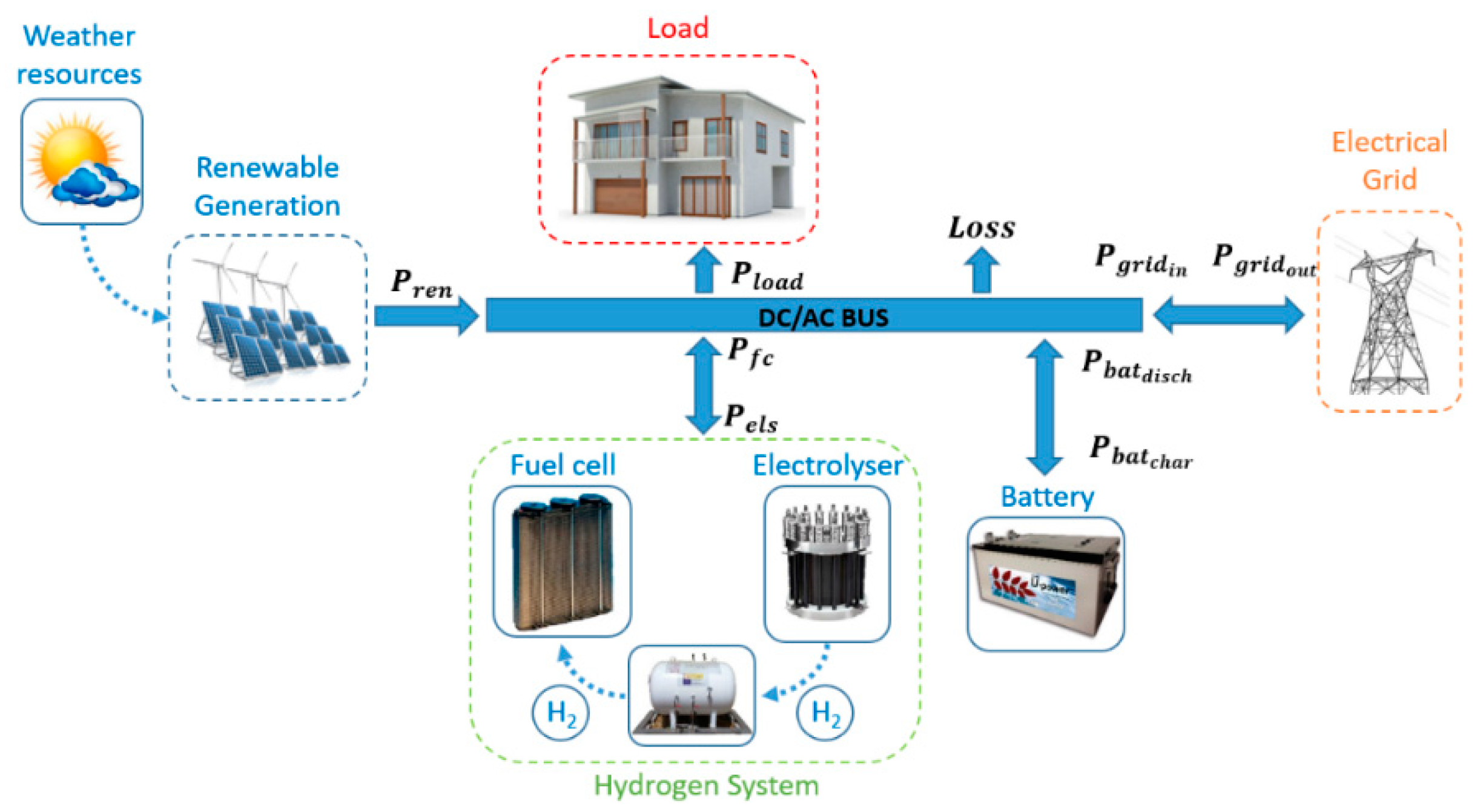
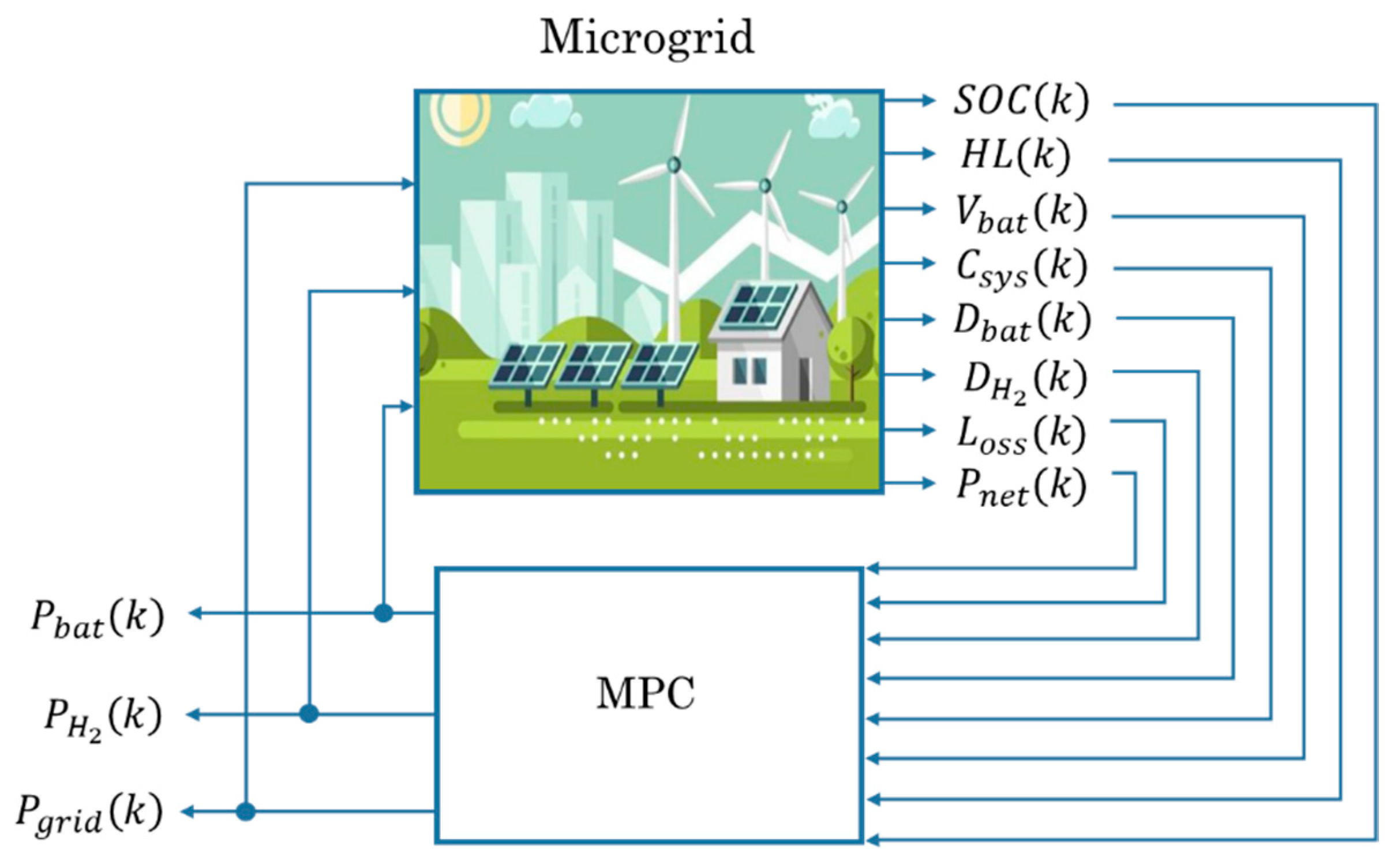
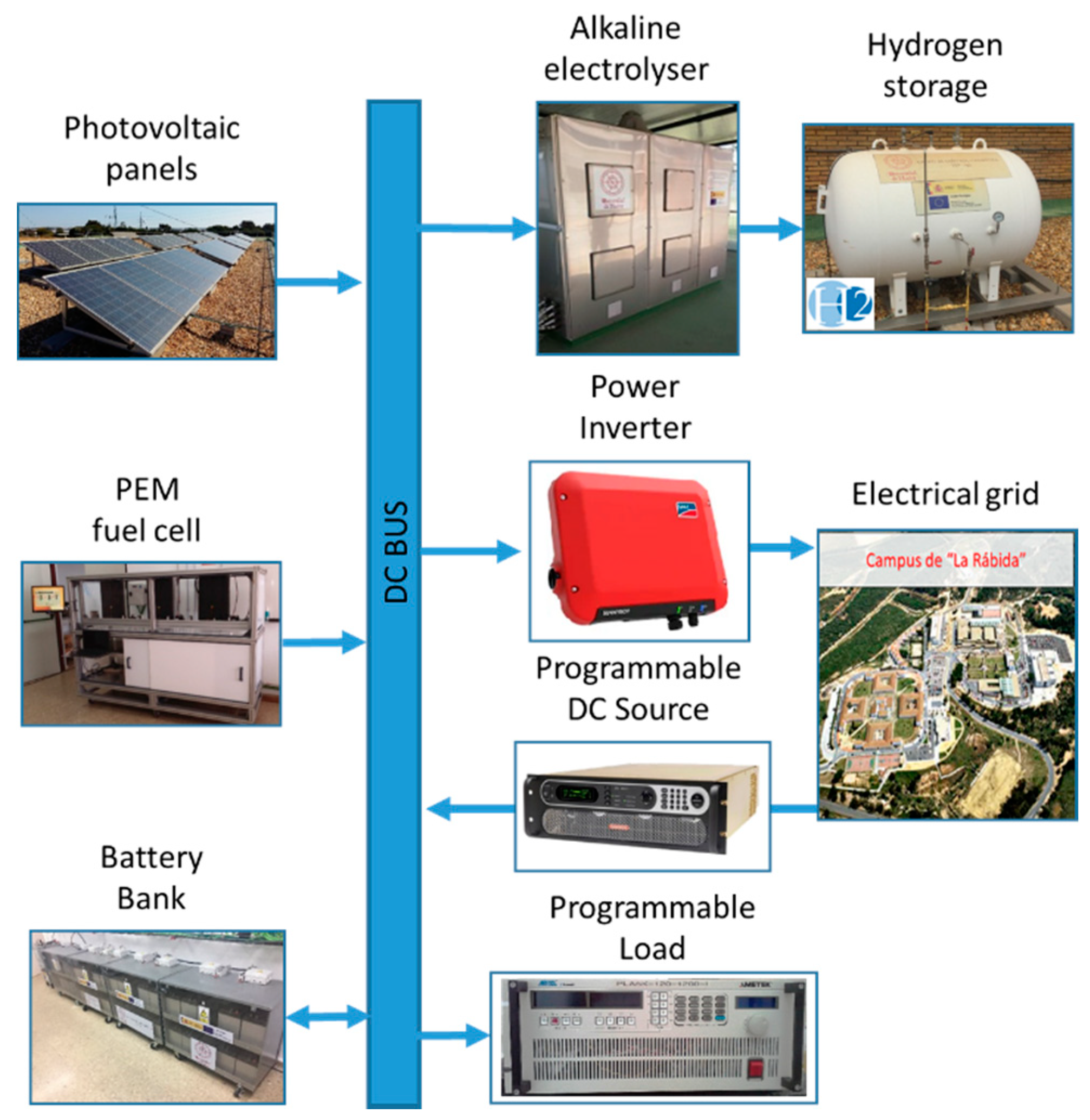
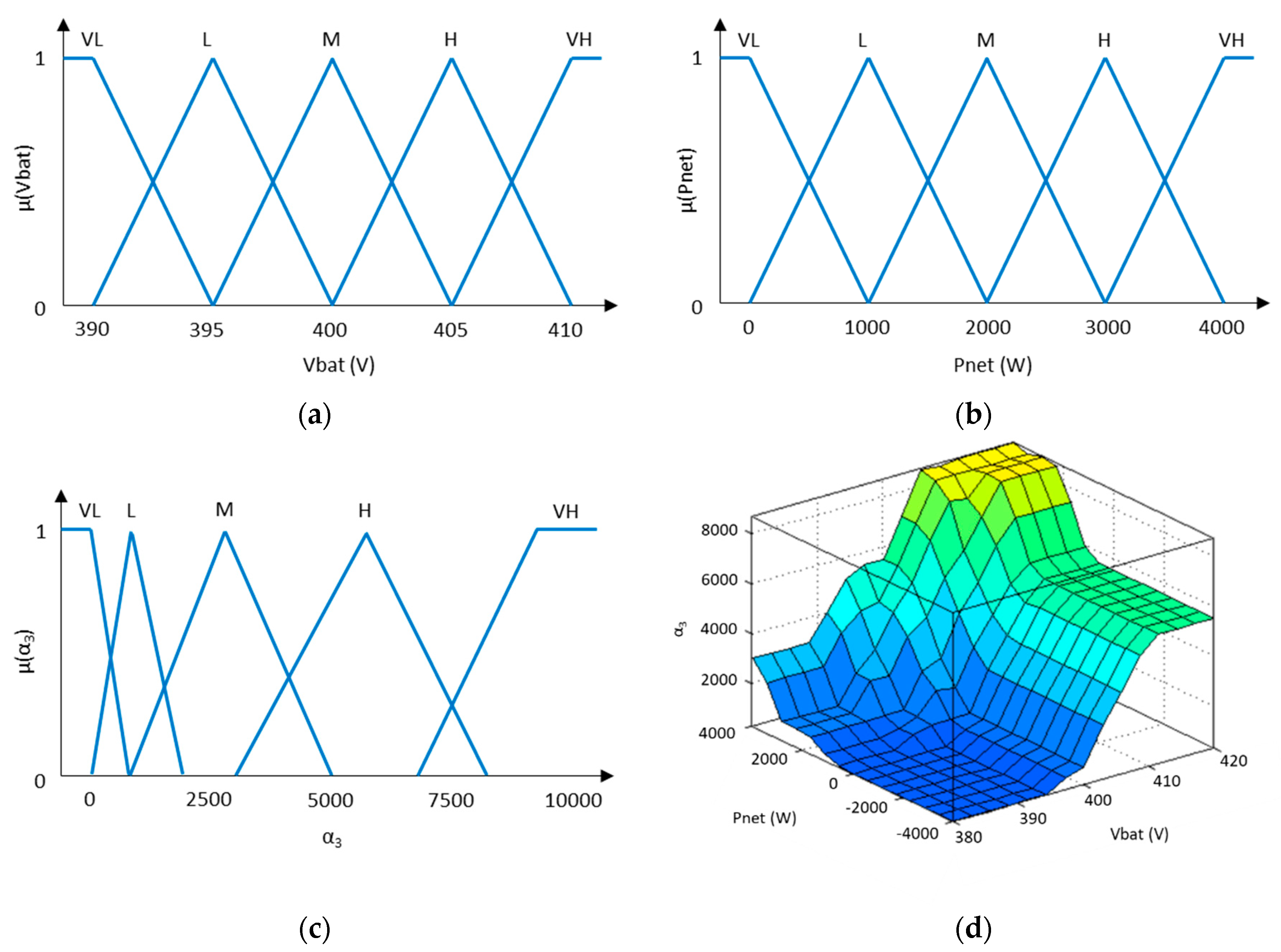
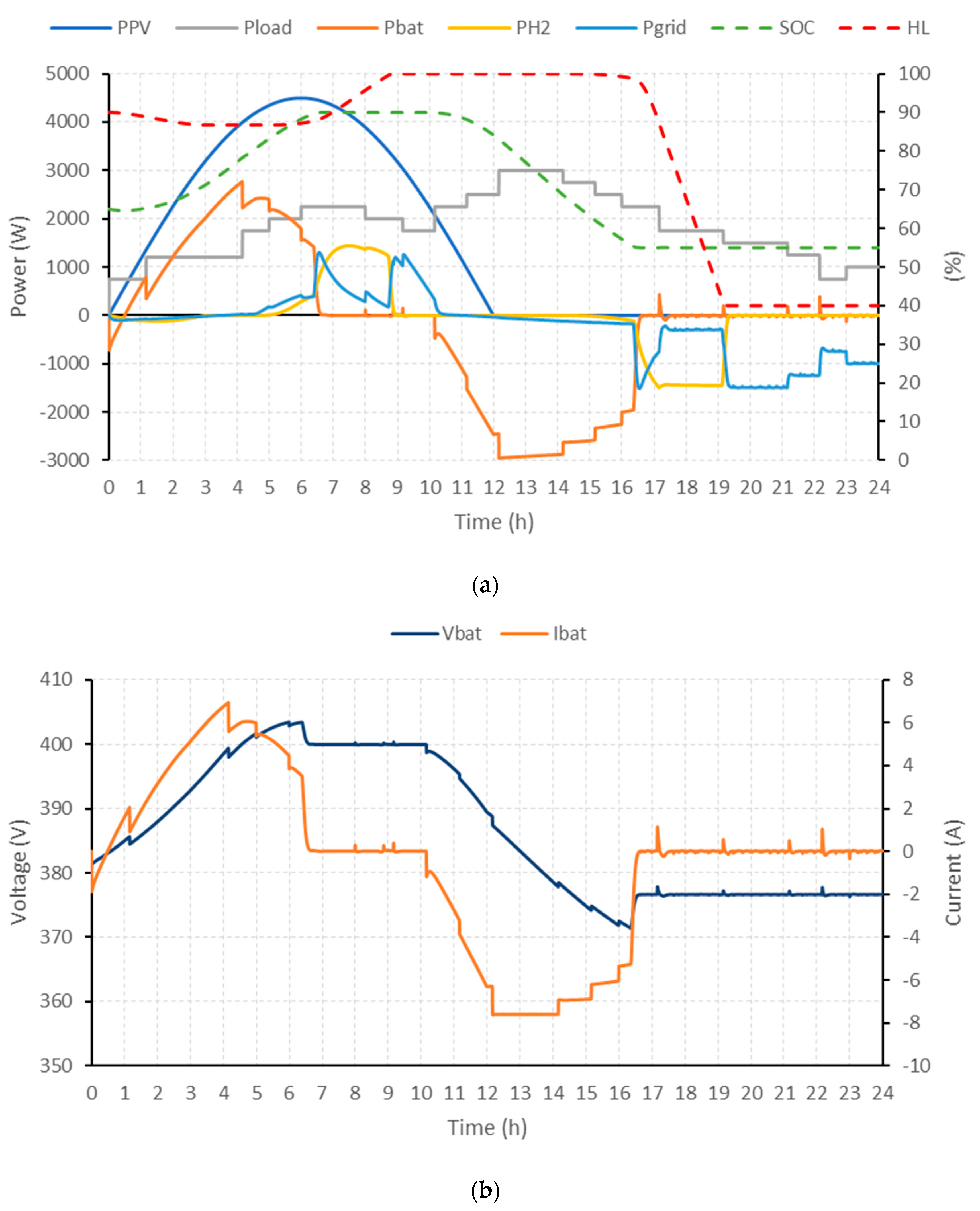
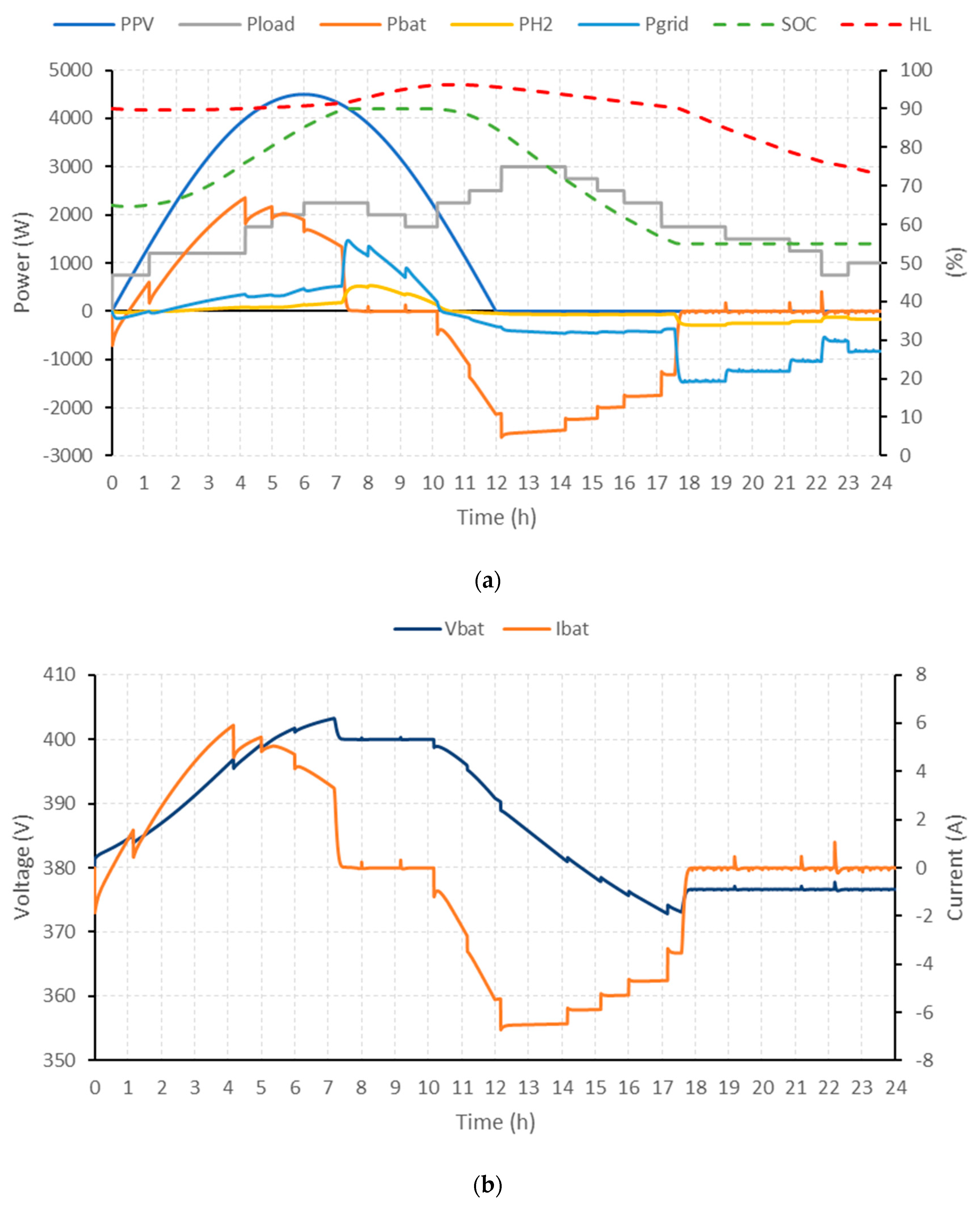
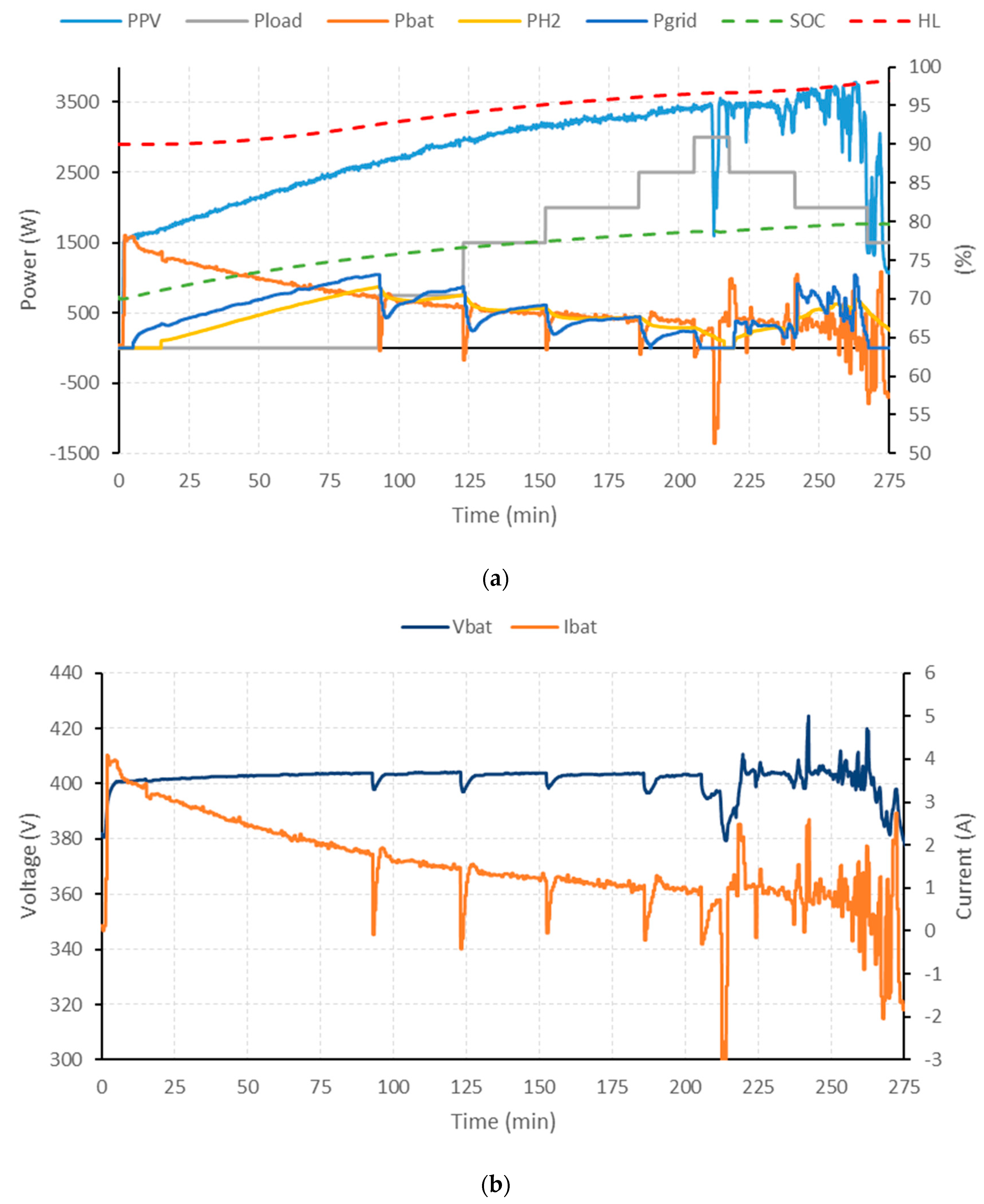
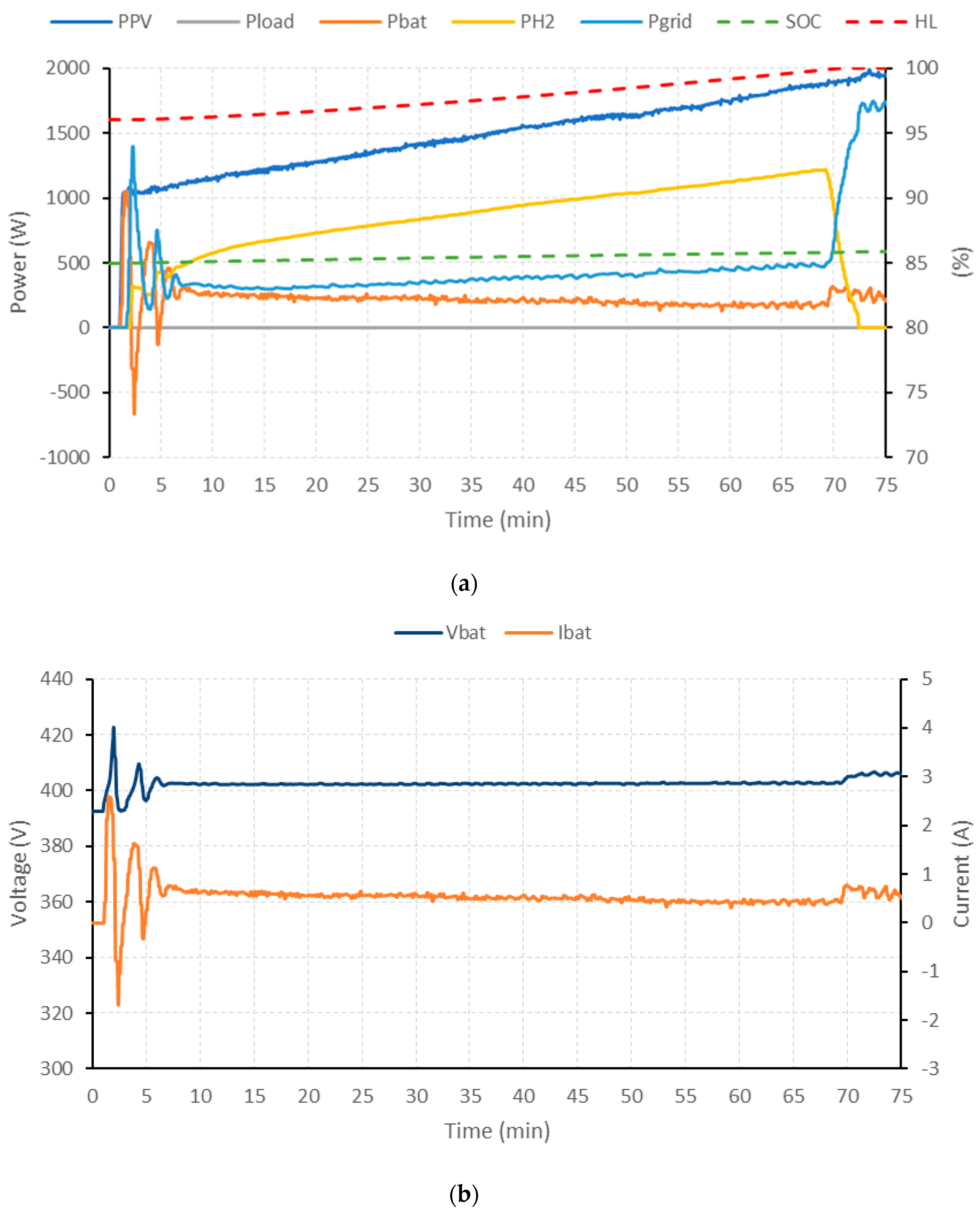
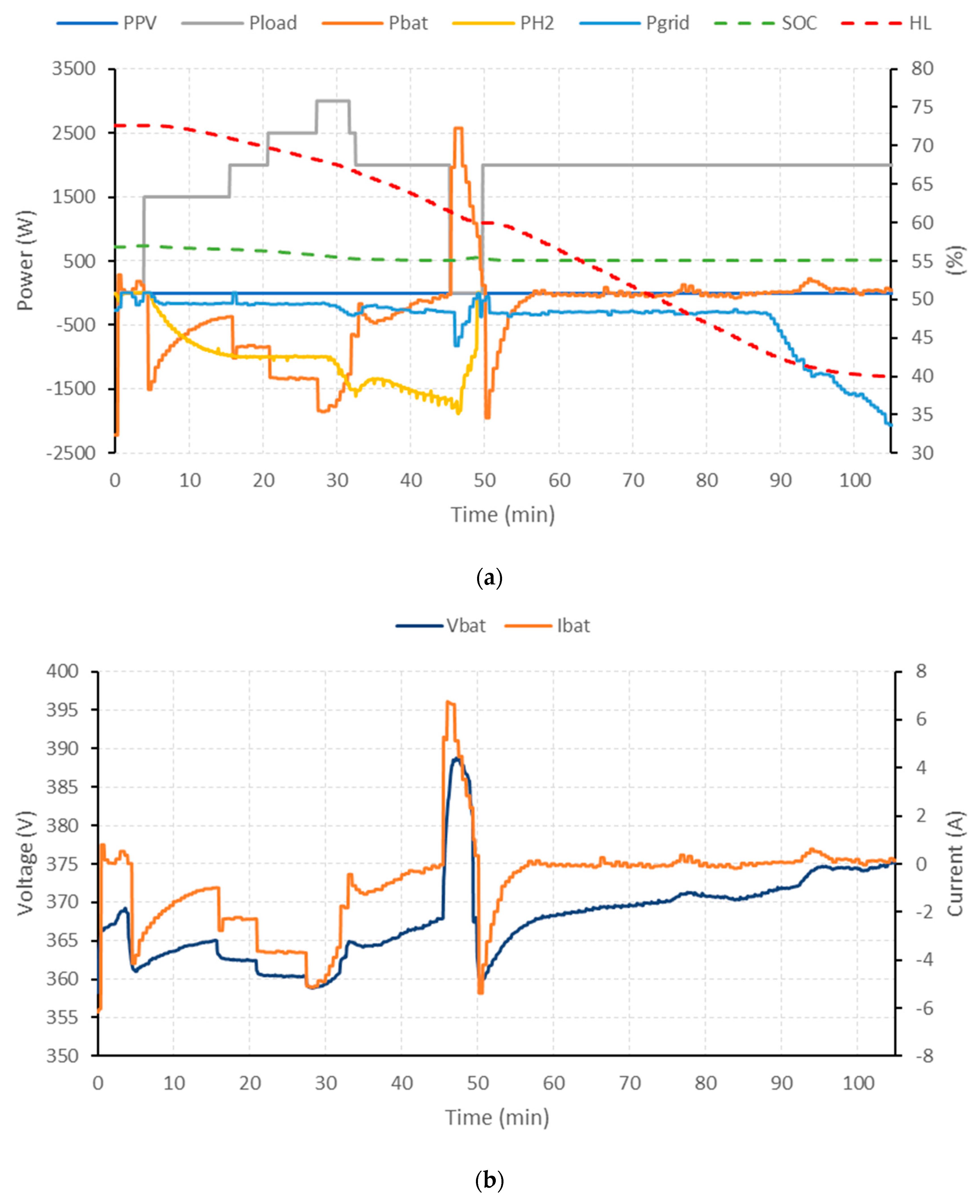
| Reference | EMS Criteria | Device Degradation | Model Approach | Battery Management Criteria | MPC Solution | Short/Long Term |
|---|---|---|---|---|---|---|
| [17,20,21,22,23,24,25] | Power balance | No | Predefined singles points | No | LTI Particularized to topology and objectives | Short term |
| [18,26,27,28,29,30,31,32] | Power balance, Economic | No | Single working points | No | LTI and MILP, MIQP Particularized to topology and objectives | Short term |
| [12,33,34,35,36,37] | Power balance, Economic based on degradation | Yes without past history | Single working points | No | MIQP Particularized to topology and objectives | Short term |
| Authors’s proposal | Power balance, Economic, Technical | Yes considering past history | Model parameter variant | SOC, Voltage, Degradation, Power variation | LPV Generalized + Fuzzy Logic | Short/Long term |
| Parameter | Means | ↑ Increase ↓ Decrease | Effect |
|---|---|---|---|
| Nu, Np | Prediction and control horizons | ↑ |
|
| ↓ |
| ||
| α1 | Weighting of the tracking error of SOC setpoint | ↑ |
|
| ↓ |
| ||
| α2 | Weighting of the tracking error of HL setpoint | ↑ |
|
| ↓ |
| ||
| α3 | Weighting of the tracking error of Vbat setpoint | ↑ |
|
| ↓ |
| ||
| α4 | Weighting of system operating costs (Csys). Influence of the economic objective | ↑ |
|
| ↓ |
| ||
| α5 | Weighting of battery degradation (Dbat). Technical objective, increases lifespan. | ↑ |
|
| ↓ |
| ||
| α6 | Weighting of H2 system degradation (DH2). Technical objective: increases lifespan | ↑ |
|
| ↓ |
| ||
| α7 | Weighting of operating losses. Technical objective: increases operating efficiency | ↑ |
|
| ↓ |
| ||
| α8 | Weighting factor of operation set point of H2 system, PH2 (control signal) | ↑ |
|
| ↓ |
| ||
| α9 | Weighting of the control signal Pgrid | ↑ |
|
| ↓ |
| ||
| α10 | Weighting of the tracking error of Pnet set point | ↑ |
|
| ↓ |
| ||
| λ1 | Defines battery dynamics. Penalizes ΔPbat | ↑ |
|
| ↓ |
| ||
| λ2 | Defines H2 system dynamics. Penalizes ΔPH2 | ↑ |
|
| ↓ |
| ||
| λ3 | Define grid dynamics. Penalizes ΔPgrid | ↑ |
|
| ↓ |
|
| Equipment | Nominal Parameters |
|---|---|
| Photovoltaic panels | Power: 5 kWp |
| Hydrogen storage | Capacity: 5 Nm3 |
| Alkaline Electrolyzer | Production ratio: 1 Nm3/h, Pressure: 30 bar, Power: 5 kWe Cost: 75,000 €. O&M Cost: 0.1 €/h. : 10,000 h |
| PEM Fuel cell | Power: 2 kWe, Cells: 80. Cost: 8000 €. O&M Cost: 0.1 €/h. : 100 mV/cell. Fuel cell deg. Ratio: 10 µV/cell/h |
| Lead-acid battery | Voltage: 34 × 12 V, Capacity: 100 Ah. Cost: 7650 €. O&M Cost: 0.001 €/h. : 40 Ah. Bat deg. Ratio: 0.000676 |
| Power inverter | Power: 2.5 kW. Grid selling cost: −0.03 €/kWh |
| Programmable DC source | Power: 15 kWp |
| Programmable load | Power: 10 kWp |
| Parameter | Value | Parameter | Value |
|---|---|---|---|
| Nu, Np | 10 | α7 | 0.01 |
| α1 | 300 | α8 | 0.01 |
| α2 | 0.01 | α9 | 20 |
| α4 | 2 | α10 | 5000 |
| α5 | 10−8 | ||
| 5 × 10−4 | |||
| 5 × 10−5 | |||
| α6 | 30 s | ||
| 85% | |||
| 4 Nm3 | |||
| 400 V | |||
| Vbat | ||||||
|---|---|---|---|---|---|---|
| VL | L | M | H | VH | ||
| Pnet | VL | VL | VL | L | M | H |
| L | VL | L | L | M | H | |
| M | L | L | M | H | VH | |
| H | L | H | H | VH | VH | |
| VH | M | H | H | VH | VH | |
Publisher’s Note: MDPI stays neutral with regard to jurisdictional claims in published maps and institutional affiliations. |
© 2020 by the authors. Licensee MDPI, Basel, Switzerland. This article is an open access article distributed under the terms and conditions of the Creative Commons Attribution (CC BY) license (http://creativecommons.org/licenses/by/4.0/).
Share and Cite
Fernández, F.J.V.; Segura Manzano, F.; Andújar Márquez, J.M.; Calderón Godoy, A.J. Extended Model Predictive Controller to Develop Energy Management Systems in Renewable Source-Based Smart Microgrids with Hydrogen as Backup. Theoretical Foundation and Case Study. Sustainability 2020, 12, 8969. https://doi.org/10.3390/su12218969
Fernández FJV, Segura Manzano F, Andújar Márquez JM, Calderón Godoy AJ. Extended Model Predictive Controller to Develop Energy Management Systems in Renewable Source-Based Smart Microgrids with Hydrogen as Backup. Theoretical Foundation and Case Study. Sustainability. 2020; 12(21):8969. https://doi.org/10.3390/su12218969
Chicago/Turabian StyleFernández, Francisco J. Vivas, Francisca Segura Manzano, José Manuel Andújar Márquez, and Antonio J. Calderón Godoy. 2020. "Extended Model Predictive Controller to Develop Energy Management Systems in Renewable Source-Based Smart Microgrids with Hydrogen as Backup. Theoretical Foundation and Case Study" Sustainability 12, no. 21: 8969. https://doi.org/10.3390/su12218969
APA StyleFernández, F. J. V., Segura Manzano, F., Andújar Márquez, J. M., & Calderón Godoy, A. J. (2020). Extended Model Predictive Controller to Develop Energy Management Systems in Renewable Source-Based Smart Microgrids with Hydrogen as Backup. Theoretical Foundation and Case Study. Sustainability, 12(21), 8969. https://doi.org/10.3390/su12218969






